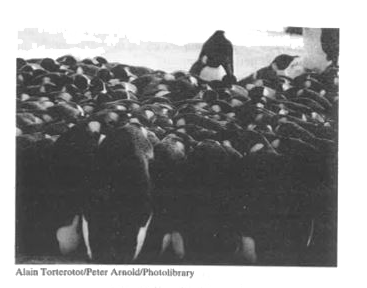Why do penguins huddle together ?
To keep warm
To lay eggs
To fly
None of these
The correct Answer is:A
Step-by-Step Solution:
1. Understanding the Concept of Huddling:
- Penguins huddle together in groups, which is referred to as a "huddle." This behavior is crucial for their survival in harsh environments.
2. Purpose of Huddling:
- The primary reason penguins huddle together is to keep warm. In the cold polar regions where they live, temperatures can drop significantly, making it essential for them to conserve body heat.
3. Energy Conservation:
- Penguins need to preserve energy because they have limited access to food. When they huddle, they reduce the amount of heat lost to the environment, which helps them maintain their body temperature and conserve energy.
4. Impact of Environment:
- The polar regions have high heat loss due to the cold air and water. Penguins face challenges in finding food in these conditions, which makes it even more important for them to stay warm while they are not eating.
5. Social Behavior:
- By staying in groups, penguins not only keep warm but also create a safer environment against predators. Huddling together allows them to protect each other while they rest or lay eggs.
6. Conclusion:
- In summary, penguins huddle together primarily to keep warm, conserve energy, and protect themselves from the harsh conditions of their habitat.
- Penguins huddle together in groups, which is referred to as a "huddle." This behavior is crucial for their survival in harsh environments.
- The primary reason penguins huddle together is to keep warm. In the cold polar regions where they live, temperatures can drop significantly, making it essential for them to conserve body heat.
- Penguins need to preserve energy because they have limited access to food. When they huddle, they reduce the amount of heat lost to the environment, which helps them maintain their body temperature and conserve energy.
- The polar regions have high heat loss due to the cold air and water. Penguins face challenges in finding food in these conditions, which makes it even more important for them to stay warm while they are not eating.
- By staying in groups, penguins not only keep warm but also create a safer environment against predators. Huddling together allows them to protect each other while they rest or lay eggs.
- In summary, penguins huddle together primarily to keep warm, conserve energy, and protect themselves from the harsh conditions of their habitat.
Topper's Solved these Questions
Similar Questions
When an emperor penguin returns from a search for food, how can it find its mate among the thousands of penguins huddled together for warmth in the harsh Antarctic weather? It is not by sight, because penguins all look alike, even to a penguin. The answer lies in the way penguins vocalize. Most birds vocalize by using only one side of their two-sided vocal organ, called the syrinx. Emperor penguins, however, vocalize by using both sides simultaneously. Each side sets up acoustic standing waves in the bird's throat and mouth, much like in a pipe with two open ends. Suppose that the frequency of the first harmonic produced by side A is fA1 = 432 Hz and the frequency of the first harmonic produced by side B is fB1 = 371 Hz. What is the beat frequency between those two first-harmonic frequencies and between the two second-harmonic frequencies?
View SolutionIn Penguin the feathers are
View Solution
Knowledge Check
Penguin is
AFlightless birdBWinged birdCBoth A and BDWingless birdPenguin is found in
AAntarcticaBArcticCTundraDAustraliaPenguin is found in
AAfricaBAustraliaCAmericaDAntartica
Penguin huddling.To withstand the harsh weather of the Antartic, emperor penguins huddle in groups ( Figure ). Assume that a penguins is a circular cylinder with a top surface area a = 0.26m2 ,and height h = 90 cm. Let Pr be the rate at which an individual penduin radiates energy to the environment (through the top and the sides ), thus NPr is the rate at which N identical, well separated penguins radiate. if the penduins radiate. If the penguis huddle closely to form a huddled cylinder with top surface area Na and height h, the cylinder radiates at the rate Ph. If N = 1000, (a) what is the value of the fraction Ph/NPr and (b) by what percentage does huddling reduces the total radiation loss ?

View SolutionName the enterprise which is the result of partnership between two companies . Why do two companies join together to work as one enterprise?
View SolutionWhy do we insure goods ?
View SolutionWhy do we group data?
View SolutionQuestion Stimulus
DIRECTIONS: Read the following passage carefully and complete the following sentences.
A penguin is a water bird that can't fly. It has webbed feet and wings that look like flippers. It uses its wing flippers for underwater swimming. Many penguins live in the icy waters in or near Antarctica. They seldom visit land except to raise their young ones. Penguins have short legs and tall, torpedo-shaped, bodies. On land they are able to stand upright, and because of their stature, they walk with a waddle. They may appear awkward, but penguins actually walk about as fast as people. They also climb rocky shores by hopping from rock to rock. Some penguins travel over ice and snow by ‘tobogganing’ sliding on their bellies. But penguins travel best by swimming, hour after hour. There are 17 species of penguins, ranging in size from the largest emperor penguin to the diminutive fairy penguin. Penguins will not cross warm ocean water; therefore, they are all found in south of the equator. The Galapagos penguin lives in the farthest north, near the equator in the cold waters around the islands of the same name.
Penguins are popular around the world, primarily for their unusually upright, waddling gait and (compared to other birds) lack of fear of humans. Their striking black and white plumage is often likened to a tuxedo suit.
When do Penguins come on land?
View Solution
